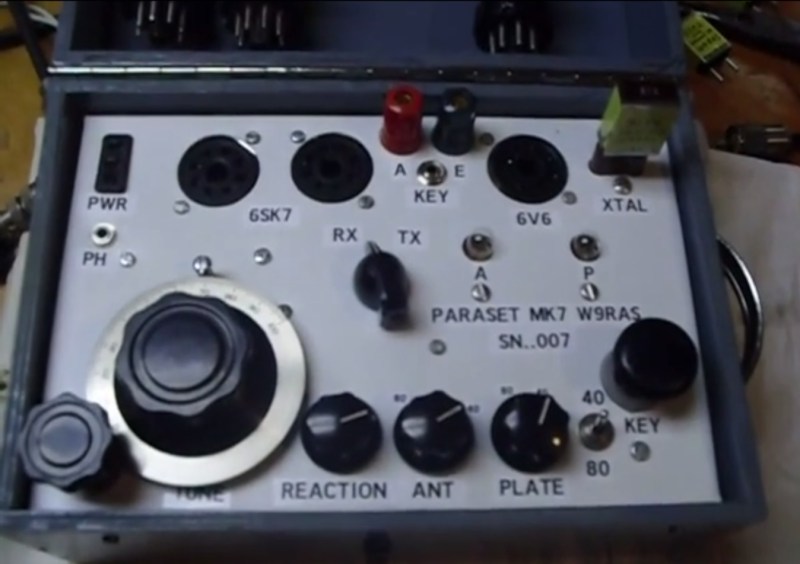[Robert Sumption] a.k.a [W9RAS] takes on the daunting challenge of building a WWII spy radio called the Paraset as the topic of this week’s Retrotechtacular. It was originally a tube based CW (Morse code) transmitter/receiver used by the French underground to communicate with the Allies. Many of these radios were dropped behind enemy lines and could run on European AC or 6 V DC with the added advantage of being able to use most anything for an antenna, including fence wire. These small, low power and highly mobile radios tuned in the 3 to 8 MHz range were instrumental in the resistance. But they still make for a really fun scratch-built radio project.
Hobby groups still build this brilliant little radio and use it regularly to make contacts at great distances using the 40 and 80 meter ham bands. This may not be a weekend project for everyone because you need to work with vacuum tubes and build a 400 V power supply to operate this type of radio. Plus, sourcing some of the old components in working order is sometimes near impossible. [Bob] circumvents some of the problems by altering the design to marry up with his surplus supply of radio bits and bobs such as tubes (a.k.a. valves) and FT243 crystals he had on hand. And don’t forget, just as [Bob] says in his 5 part build video seen after the break; “Every day is a Hamfest on eBay”. So getting some of these parts, if not a partial-intact original Pareset radio, is always possible.
If you search on the Internet for “PARASET RADIO” you will find other home-built examples with circuit diagrams and plenty of advice such as found on W7OIL.com and SHAW.ca.
part 1
part 2
part 3
part 4
part 5
Retrotechtacular is a weekly column featuring hacks, technology, and kitsch from ages of yore. Help keep it fresh by sending in your ideas for future installments.

















Awsome stuff – keep this coming!
agreed
Totally AWESOME… REAL RADIO not no mp3 junk!
It’s not even *modulated*… Unless you count turning the output on and off.
It is a CW rig.
Well, at this moment it’s was not 220V used for domestic power, but more something around 110V (not completly normalised and different voltage from legacy network still existing).
In the 60s most european country double this voltage (decision was make in 1960 for France) for reducing current, joule effect and voltage drop.
And all western european country switch to 230V in 1986 (unifying between 220 and 240V country)
My bad. I had read it ran on European household power and just assumed it meant 220v. I have removed the error. Thanks.
A brain injury killed my Morse code I should get back to recovering it so I can make and play with simple radio projects. I keep simple hand tools around because often they can do a job and leave a better finish with wood. A fairly decent back saw and a miter box for cross cuts can be found new at a reasonable price. Rip saws are hard to find either new or used. I do like seeing RF projects featured here. I wonder how many “preppers” are out there squirreling a away old tubes and stuff so they can communicate.
You should explain to people that “preppers” are conservative gunbots who stock up on a bunch of guns and ammo (to shoot the rest of us with) and occasionally also buy a home generator or whatever. But the main thing is to shoot the rest of us and take what you need – right, big guy?
Dumb, Mike T, really dumb.
Main power was 110V on continental Europe until the sixties.
Nice stuff !
I have learned that from above comment. I had read it ran on European household power and just assumed it meant 220v. I did make a correction to remove the reference to any AC voltage value. Thanks.
SN 007….. really…..
Very very cool project. I really appreciate you’re sharing it with us.
73… WA6IKO
Coil winding data would be helpful.
Here is mine. Have not had it on the air yet.
Bill – K5MIL
http://radioremembered.org/images/Paraset/ParasetTop.1.JPG
http://radioremembered.org/images/Paraset/ParasetBot.1.JPG